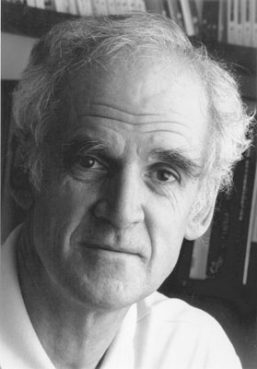
(RNS2-MARCH14) Charles Taylor, a Canadian philosopher whose work has touched on
questions of spirituality, violence and culture, was awarded the 2007 Templeton Prize on
Wednesday. For use with RNS-TEMPLETON-PRIZE, transmitted March 14, 2007. Religion
News Service photo courtesy John Templeton Foundation.
NEW YORK — Bernard d’Espagnat, a renowned French physicist whose research has centered on hidden realities that are “beyond our possibilities of description,” has won the 2009 Templeton Prize, valued at $1.42 million.
D’Espagnat becomes the latest in a series of physicists and cosmologists whose work at the intersection of religion and science has won the Templeton Prize, the world’s single largest annual award given to an individual.
A professor emeritus of theoretical physics at the University of Paris-Sud, d’Espagnat is perhaps best known for his research into what he terms “veiled reality” — a domain that underlies energy, matter, space and time — and the ways that science can help reveal the nature of reality.
D’Espagnat, 87, was an early visionary in the burgeoning field of science, religion and philosophy. He played a prominent role in the theoretical developments of research that combined information science, mathematics and physics into what is called “quantum information science.”
The French scholar “has constructed a coherent body of work which shows why it is credible that the human mind is capable of perceiving deeper realities,” Nidhal Guessoum, chairman of physics at the American University of Sharjah in the United Arab Emirates, wrote in nominating d’Espagnat for the Templeton Prize.
In remarks prepared for the announcement of the award Monday (March 16) in Paris, d’Espagnat said the “ground of things … lies beyond the reach of conceptualized knowledge, and mystery is not therefore something negative that has to be eliminated. On the contrary it is one of its constitutive elements.”
As a result, he said, any conflict “between science and religion therefore vanishes.”
The 2009 prize is the first to be awarded following the death of its founder, philanthropist and global investor Sir John M. Templeton, who died last July at the age of 95. The award honors a living person “who has made an exceptional contribution to affirming life’s spiritual dimension, whether through insight, discovery, or practical works,” according to the John Templeton Foundation, which is based in West Conshohocken, Pa.
Previous winners include evangelist Billy Graham, the late Mother Teresa and the late Russian author Aleksandr Solzhenitsyn.
In keeping with Templeton’s wishes, the prize’s monetary value must always exceed that of the Nobel Prizes because of Templeton’s belief “that benefits from discoveries that illuminate spiritual questions can be quantifiably more vast than those from other worthy human endeavors,” the foundation said.
(OPTIONAL TRIM FOLLOWS)
In his formal announcement of d’Espagnat’s prize, John M. Templeton Jr., chairman and president of the John Templeton Foundation, said d’Espagnat is well within the tradition of recent Templeton winners who are concerned with the ways that religion and science can inform humanity about the nature of reality.
“Instead of simply measuring the limits of quantum physics,” Templeton said, “he (d’Espagnat) has explored the unlimited, the openings that new scientific discoveries offer in pure knowledge and in questions that go to the very heart of our existence and humanity.”
The son of a post-impressionist painter, d’Espagnat had an initial sense of beauty and its connection to the cosmos as a young man while riding his bicycle through a French country garden. That was something he regarded as a sort of “signpost” to an underlying reality.
In d’Espagnat’s youth, classical science — particularly physics — was confident that “religion would be washed away,” he said in an interview. D’Espagnat, a Roman Catholic by birth who says his work is not grounded in a specifically Catholic outlook, said it is remarkable that as he nears the age of 90, the realms of science and religion have found common ground, with both affirming there is a reality beyond what is knowable.
“No scientist would like to be called a radical idealist,” d’Espagnat said. But “veiled reality,” he said, reflects a belief that there are things “beyond our possibilities of description.”
Asked what he would do with the prize money, d’Espagnat said he planned to contribute some toward scientific research and some to organizations in France assisting the homeless and impoverished. He also said he would spend some so that he and his ailing wife could enjoy their future years together at their home in Paris.
Britain’s Prince Philip, the Duke of Edinburgh, will present d’Espagnat the Templeton Prize at a private ceremony at Buckingham Palace in London on May 5.




